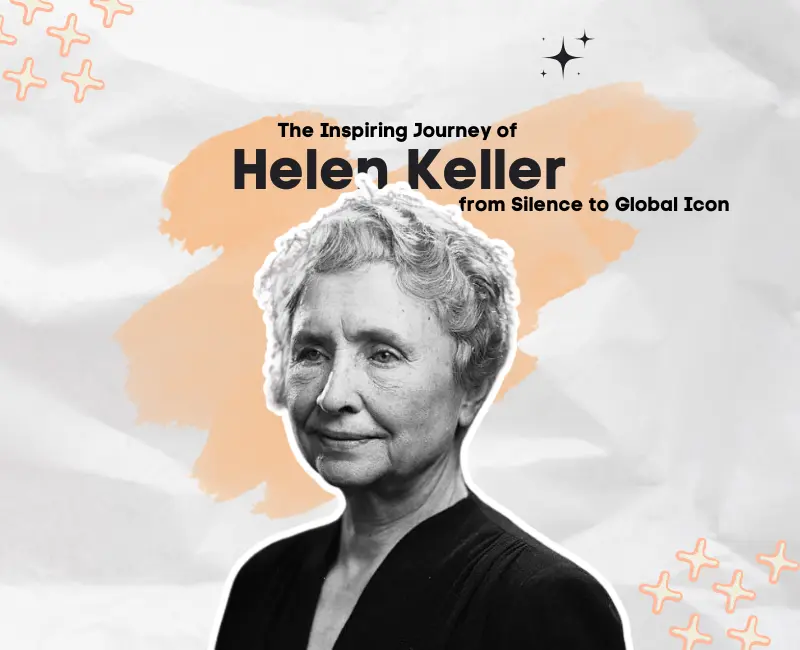Breaking Barriers: The Inspiring Journey of Helen Keller from Silence to Global Icon

Helen Keller’s life is one of the most remarkable stories of triumph over adversity. Born in 1880 in Tuscumbia, Alabama, Helen lost both her sight and hearing as a toddler due to a severe illness. Isolated in a world of silence and darkness, her early years were filled with frustration. But everything changed when Anne Sullivan, a determined and innovative teacher, entered her life. With Sullivan’s guidance, Helen discovered language and unlocked the power of communication, beginning a journey that would inspire the world.
Keller became a pioneer, proving that physical limitations could not define a person’s potential. As the first deafblind person to earn a college degree, she broke barriers in education and advocacy. A prolific author, speaker, and activist, she championed the rights of individuals with disabilities, women, workers, and marginalized communities. Her autobiography, The Story of My Life, continues to resonate as a testament to resilience and the power of determination.
Helen Keller’s legacy is not just about overcoming personal challenges—it’s about using her voice to fight for a more inclusive and just world. Her life is a powerful reminder that courage, education, and compassion can change lives and shape history.
Early Life and Education
A sudden and life-altering illness profoundly shaped Helen Keller’s early life. Born on June 27, 1880, in Tuscumbia, Alabama, Helen was a healthy and lively child until an illness, possibly scarlet fever or meningitis, struck when she was just 19 months old. The illness left her blind and deaf, plunging her into a world of silence and darkness. Her parents, Captain Arthur Keller and Kate Keller were devastated by this transformation and struggled to find ways to help their daughter adapt to her new reality. Without the ability to see, hear, or communicate, Helen became increasingly frustrated, often lashing out in anger. Her inability to express herself or understand the world created significant challenges for her family and herself.
Despite her limitations, Helen displayed remarkable intelligence and curiosity even as a child. She invented signs to communicate basic needs, which were often misunderstood, deepening her sense of isolation. Her parents recognized her potential and sought professional help. Their search led them to contact Alexander Graham Bell, the telephone inventor and a prominent advocate for people who are deaf or hard of hearing. Bell referred them to the Perkins School for the Blind in Boston, where Anne Sullivan, a young and determined teacher, was recommended to work with Helen. This decision would prove to be life-changing.
Anne Sullivan’s arrival at the Keller household in 1887 began a transformative chapter in Helen’s life. Sullivan, who was visually impaired, deeply understood Helen’s challenges. She began teaching by spelling words using a manual alphabet in Helen’s hand. Initially, Helen did not grasp the concept, but a breakthrough came when Sullivan spelled “water” into her hand while running cool water over it. At that moment, Helen connected the sensation with the word, unlocking the door to language and communication. This breakthrough ignited her hunger for knowledge and began her extraordinary learning journey. Sullivan’s patience, innovative methods, and unwavering belief in Helen’s potential enabled her to overcome her frustrations and embrace the joy of understanding and expression.
Though marked by challenges, Helen Keller’s early life laid the foundation for her later achievements. Her resilience and intelligence, coupled with the support of her family and the dedication of Anne Sullivan, allowed her to transcend her disabilities. These formative years demonstrated that with the proper support and determination, even the most formidable barriers could be overcome, paving the way for Helen to become a global symbol of perseverance and hope.
Education and Intellectual Achievements
Helen Keller’s educational journey is a testament to her extraordinary determination and intellectual brilliance. Her formal education began under the patient guidance of Anne Sullivan, who employed innovative teaching methods tailored to Keller’s needs. Sullivan taught Keller to communicate by spelling words into her hand, beginning with “water,” which became the breakthrough moment that opened up a new world of learning. Keller quickly mastered the manual alphabet and Braille, laying the foundation for her academic journey. Sullivan’s unwavering dedication and creative approach to teaching ensured that Helen could access and excel in subjects traditionally deemed impossible for someone with her disabilities.
Helen’s pursuit of knowledge led her to attend several prestigious institutions. After excelling in her preliminary studies, she enrolled at the Cambridge School for Young Ladies in preparation for higher education. In 1900, she achieved a historic milestone by being admitted to Radcliffe College, the women’s counterpart to Harvard University. Despite the immense challenges posed by her disabilities, Keller graduated cum laude in 1904, becoming the first deafblind person to earn a Bachelor of Arts degree. Her academic success was made possible through tireless effort, an insatiable curiosity, and Anne Sullivan’s assistance, who painstakingly interpreted lectures and course materials into Keller’s hands.
Keller demonstrated a remarkable aptitude for languages and the humanities throughout her academic journey. She learned to communicate in several languages, including French, German, Latin, and Greek and cultivated a deep appreciation for literature, philosophy, and history. These intellectual achievements were personal victories and symbols of what individuals with disabilities could accomplish when given the proper support and opportunities. Keller’s education was a powerful statement to the world that intellectual potential knows no boundaries. Her trailblazing success inspired educational reforms and greater inclusivity for individuals with disabilities, leaving a lasting impact on academic institutions and society.
Writing and Advocacy
Helen Keller’s writing and advocacy work transformed her personal story into a powerful platform for global change. After mastering communication through the tireless efforts of her teacher, Anne Sullivan, Keller began sharing her experiences and insights with the world. Her first significant work, The Story of My Life (1903), detailed her journey from isolation to self-expression, providing an intimate look into her struggles and triumphs. This autobiography, written while she was still a student at Radcliffe College, garnered widespread acclaim and has been translated into numerous languages, inspiring countless individuals with disabilities and their families. Her later works, such as Midstream: My Later Life and Optimism: An Essay, reflected her profound philosophical beliefs and unwavering hope in the human spirit.
Beyond her literary contributions, Keller became a dedicated activist, using her unique voice to champion the rights of marginalized communities. She worked closely with organizations like the American Foundation for the Blind (AFB), where she played a pivotal role in improving access to education, resources, and employment opportunities for people with visual impairments. She also advocated for policies that addressed broader societal inequalities, such as access to healthcare and education for all individuals, regardless of their abilities. Her advocacy extended beyond disability rights, encompassing issues like women’s suffrage, racial equality, and workers’ rights, making her a multifaceted activist for social justice.
Keller’s advocacy took her across the globe, where she delivered lectures, met with world leaders, and inspired movements for change. Despite being unable to see or hear, she connected deeply with audiences through her poignant speeches, often interpreted by Sullivan or later by Polly Thomson, her companion and secretary. Keller’s activism was firmly rooted in her belief that education and empathy could break down barriers of prejudice and ignorance. Her unwavering commitment to social causes made her a pioneer in intersectional advocacy, addressing the interconnectedness of various forms of oppression. By her death in 1968, Helen Keller had not only changed perceptions of what people with disabilities could achieve. Still, she had also left a lasting legacy as a fearless advocate for human rights.
Legacy and Impact
Helen Keller’s legacy is a testament to the transformative power of perseverance, education, and advocacy. She demonstrated that no matter how severe, physical limitations could not constrain the human spirit or its potential to achieve greatness. Keller’s triumphs as a deafblind individual who mastered multiple languages graduated from college and became a world-renowned speaker and writer inspired countless others facing similar challenges. Her story challenged societal perceptions of disability, proving that individuals with disabilities could lead rich, impactful lives when given the right opportunities and support.
Beyond her achievements, Keller was a trailblazing advocate for social change. She worked tirelessly to improve the lives of people with disabilities, collaborating with organizations like the American Foundation for the Blind (AFB) to enhance accessibility and education. Keller’s work helped pave the way for modern disability rights movements and the implementation of policies ensuring equal opportunities for individuals with disabilities. Her advocacy extended beyond disability rights; she was a vocal proponent of women’s suffrage, labor rights, and racial equality, embodying an intersectional approach to activism long before the term became widely recognized.
Keller’s impact continues to resonate in the 21st century. Her life story is taught worldwide as a symbol of resilience, empathy, and the power of education. The Helen Keller International organization, which she co-founded in 1915, remains a leader in combating blindness and malnutrition globally. Her work has inspired those facing physical challenges and anyone striving to overcome adversity or effect social change. Helen Keller’s legacy is a powerful reminder that determination, education, and compassion can leave a lasting mark on the world, motivating generations to push beyond limitations and advocate for a more inclusive society.
Conclusion
Helen Keller’s life is a shining example of how courage, determination, and education can transform even the most daunting challenges into opportunities for growth and impact. Despite being deaf and blind, she shattered societal barriers, proving that physical limitations do not define a person’s worth or potential. Through her advocacy, she not only uplifted individuals with disabilities but also championed causes such as women’s rights, labor reform, and social justice. Her legacy is a source of inspiration for those striving to overcome adversity and working to create a more equitable world. From her groundbreaking educational achievements to her relentless activism, Keller’s journey reminds us of the power of resilience and the importance of fostering inclusivity. Organizations she inspired and co-founded, like Helen Keller International, carry her mission forward, making a tangible difference in lives across the globe. Helen Keller’s story is not just about overcoming personal challenges—it is a call to action. It urges us to break down barriers, stand up for the marginalized, and believe in the boundless potential of every individual. Her life serves as a timeless beacon of hope, reminding us that we can change the world with determination and compassion.


